Susan Price's Blog: Susan Price's Nennius Blog
April 26, 2019
The Joy of Notebooks? -- Nah.
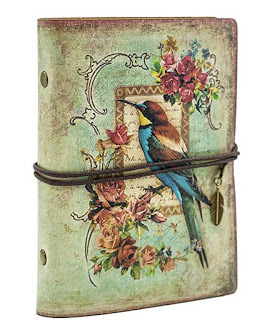 Here, a beautiful notebook. Only a tenner.Earlier this month my Authors Electric colleague, Lynne Garner,asked us what we like to write with.
Here, a beautiful notebook. Only a tenner.Earlier this month my Authors Electric colleague, Lynne Garner,asked us what we like to write with.She mentioned that she had 'many, many notebooks' which she preferred to use when writing poetry. A writer she said, could not have too many notebooks, especially if they were lovely.
Lynne is far from alone in thinking this. Over the years, I've heard dozens of writers sing the praises of their notebooks: the moleskin ones, the leather bound ones, the ones with lovely floral or shiny covers. I've heard many writers say that they keep special notebooks to write down ideas in, and many say that they can't start a new book until they find that special notebook which is just perfect for that particular idea.
This all makes me feel quite left out as in my entire writing career of nearly fifty years I have never, ever given a single spit about any notebook. I buy 'em cheap, treat 'em mean and discard 'em without a thought.
I'm not trying to say that I am right in this and everyone else is wrong -- not at all.
 Find it hereI've always thought that writers should adopt whatever method helps them to get the words written (short of GBH or murder.) And if beautiful notebooks do it for you, then stack them high. Put aside money to buy them. If you need a particuarly beautiful notebook in order to get the idea down on paper, then you need it and there's nothing more to be said.
Find it hereI've always thought that writers should adopt whatever method helps them to get the words written (short of GBH or murder.) And if beautiful notebooks do it for you, then stack them high. Put aside money to buy them. If you need a particuarly beautiful notebook in order to get the idea down on paper, then you need it and there's nothing more to be said.But I feel there may be those like me who, indifferent to the allure of notebooks, are asking themselves: Can I really be a writer at all, if I don't have a notebook habit? I want to reach out to those writers and assure them that, yes, there is writing without beautiful notebooks.
I have what I think many would feel is a depressingly pragmatic approach to writing, as to most other things in life. Easy and cheap, that's all I ask.
I used to write by hand a lot before PCs happened. Not because of any spiritual feeling of closer contact with the ideas that flow from my heart to my hand (as I've heard some writers put it.) No: it was simply that it was slightly easier than using a big, heavy, clumsy typewriter.
I used to write so much, for so long that I had the most impressive writers' cramp I've ever seen. Not just an achy hand -- not just a trembling hand. My right hand used to go into such violent spasms that it jerked up as high as my shoulder and threw the pen across the room. Which is one way of saying: I've had enough!
That's when I found that I could write almost as well with my left hand as with my right, especially if I turned the paper sideways (a tip from my left-handed aunt.) Not as legibly, but good enough. Several members of my family are left-handed but I'd never had a problem with using my right and had never tried writing left-handed until I wore my right hand out.
For a while I wrote with a typewriter. I never liked it much, but the electric one made it slightly quicker and easier than writing by hand, most of the time. As soon as I could get a computer, I started writing directly onto a computer almost all the time: rough drafts, rewrites, fiction, non-fiction, it doesn't matter. Because it's easier. That's the whole of it. No matter how beautiful the notebook is, I can't grab a whole paragraph and shift it to elsewhere on the page, as I can with a computer. I can't over-write in a notebook. I can't easily add a lot of notes to the end of a day's writing, in different colours and fonts -- and then, next day, shift them around until I decide on the strongest and then over-write them.
I do sometimes do a pubowrimo -- that is, when I'm not getting any writing done, I take a notepad and pen to a pub and write there. But it's the change of scene that's important, the break in routine, not the notepad.
I always use the biggest, cheapest writing pads I can find. And I write from margin to margin, side to side and top to bottom. I think this comes from having been raised in a household where money was scarce, but almost everyone drew and wrote. Drawing and writing pads were jealously guarded and often hidden (since an artist will scribble sketches on the nearest available paper. You have to watch artists.) When I write in a notepad, the idea of leaving wide margins or blank pages to add revisions is against every instinct I learned as a child.
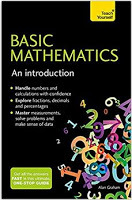 Basic MathematicsWhile writing on holiday, I have used notepads, simply because it's more convenient than lugging some electronic device around. I've gone to the local store on some small Hebridean or Greek island and bought the cheapest writing pad they have, of whatever kind -- school exercise types or 'reporter' notebooks. I scribble in it, type up what I've written when I get home, and probably never look at the writing pad again. (Except I am currently using an old reporter type to do hard sums in as I work through Mathematics: A Complete Introduction. I decided to stop being 'bad at maths.' (Or, at least, not as bad.)
Basic MathematicsWhile writing on holiday, I have used notepads, simply because it's more convenient than lugging some electronic device around. I've gone to the local store on some small Hebridean or Greek island and bought the cheapest writing pad they have, of whatever kind -- school exercise types or 'reporter' notebooks. I scribble in it, type up what I've written when I get home, and probably never look at the writing pad again. (Except I am currently using an old reporter type to do hard sums in as I work through Mathematics: A Complete Introduction. I decided to stop being 'bad at maths.' (Or, at least, not as bad.)I've never kept a notepad of ideas because I know that I would never look back at what I'd written. I've always believed that, if I have a good idea, I'll remember it. I may forget it for a while, but it will eventually come back, bringing friends with it. I think a notepad -- even if I looked at it often, which I wouldn't -- would tend to fix the idea as a first thought, whereas I want it to stay fluid. This may not be the case with others but I know all too well how literal and single-tracked my mind can be. I don't need to encourage that tendency.
As for finding a new, lovely notebook for every new book I write... Nah. I dither about starting something new as much as anyone. I may even do a pubowrimo to get into it. But the pad I write in will be some big, lined, supermarket cheapie. Probably one I've already scribbled other stuff into.
There is no romanticism in my writing soul. I once amused my editor at Faber, Phyllis Hunt, when she asked me if I was writing anything. I said I had 'a couple of things up on the stocks.' "Oh, they're boats?" she said.
I thought about it and said, "They're something that I'm hammering together out of bits of old orange crates and scrap." I admit, it does faintly annoy me when writers (such as Dickens) compare their books to babies or children. I hammer my stuff together. I tear it down and rebuild it. I clear the site and make good. Children aren't allowed on building sites. I've no doubt that this 'hard-hatted worker on a building site' metaphor is found intensely annoying and posey by many, but for me, it chimes better with my attitude to my work. I don't wipe my stories' noses.
Pens, though. That's different.I don't care much about the paper, but difficult pens infuriate me. Lynne said she dislikes biros and fountain pens, and I agree. Both were banes of my school days. Fountain pens, as Lynne observes, spread ink everywhere except where you wanted it. Biros were uncomfortable to hold and their ink was always turning sticky and blobby, making writing difficult.
 uniball vision elite pensMy pen has to be a roller-ball and not just any one. It has to move fast and freely over the paper, in the right or left hand. Not all 'rollerball' pens are made equal. Some catch and scratch and they are quickly discarded. The ones I'm using at the moment are called 'uniball vision elite' and they're very smooth, fast and scribbly.
uniball vision elite pensMy pen has to be a roller-ball and not just any one. It has to move fast and freely over the paper, in the right or left hand. Not all 'rollerball' pens are made equal. Some catch and scratch and they are quickly discarded. The ones I'm using at the moment are called 'uniball vision elite' and they're very smooth, fast and scribbly.Just as in my childhood, I find I have to hide good pens. I am beseiged by artists and crossword and sudoki addicts. If I don't hide my best pens and deny that I have them, they are filched to make quick sketches or fill in 3 Down. I will never see that pen again. I've learned, if asked to lend them that pen I was using earlier, to say that I lost it, left it in the cafe, dropped it overboard in the Pentland Firth. Or, cunningly, to have an inferior biro to hand that I can lend them.
If there's a moral to this blog, it's simply that you can be a writer without adding beautiful, expensive notebooks to your shopping list -- although if they seem to help you write, then fill your trolley.But fast, scribbly pens are essential. You should always have a few packets of such pens hidden about the place. Never tell an artist or a sudoku addict where they are. Artists and sudoku addicts have no morals when it comes to paper and pens. They will take your last notebook and -- far worse -- your last pen.
https://www.susanpriceauthor.com/

Published on April 26, 2019 16:00
January 25, 2019
Sculptures Telling Stories
You might well have heard of the Kennis brothers before.
If you have, never mind. An excuse to look at their work again is always a good thing.
The Kennis brothers, Adrie and Alfons, are unsettlingly identical
Dutch twins. They refuse to call themselves artists, though they are. They are also anatomists and anthropologists and they create the most startlingly original portraits of ancient people that I’ve ever seen.
I was unaware of their work until my brother (and illustrator) Andrew, started outgrabing about a programme we were watching. It had one of those forensic recreations based on a medieval skull. The result always looks much the same, whatever skull is being used: a bland, expressionless face, rather like that of a shop-window dummy.
“Don’t waste our time!” Andrew said. “Send for the Kennis brothers! There should be a law that only the Kennis brothers are allowed to do reconstructions!"
I had never heard of the brothers Kennis, but once directed to their website, I could see Andrew’s point. When you look at one of their recreations, it looks back. It almost speaks. You feel that if you could catch it at the right moment, it would tell you a joke or the story of its life. And I would be all ears.
I think the Kennises refuse to call themselves artists because everything they do is based on research and evidence. Their approach is meticulous. Each of their sculptures is based on an individual skeleton. After much research into the anatomy of that individual and its species, they first build a skeleton -- a neanderthal skeleton or an erectus skeleton. They even build it a flexible spine.
They add muscles of clay. They add rope for arteries. They layer on the skin in translucent layers of silicon, as an oil painter does with layers of coloured pigment.
They don’t guess at the colouring. DNA analysis provides them with the most likely eye, hair and skin colour. One of their most controversial – and beautiful – sculptures is based on the skull of a young man found in Cheddar Gorge. Often known as ‘the oldest Briton’ he dates from 10,000 years ago. (Though one of his direct descendants was found living just down the road. And it's reckoned that 10% of modern Britons are descended from him. That's about six and half million of us.)
The Kennises portrayed him as having dark, wavy hair, quite dark brown ‘black’ skin and blue eyes.
Some people were simply surprised, especially by the contrast between the dark skin and light eyes. But there was the usual ‘political correctness gone mad’ reaction from the usual sources, with the insulting implication that the Kennis brothers had given their subject this colouring on a whim, to gain publicity or kudos for being ‘woke’ and ‘progressive.’
The truth is, they gave him that colouring because that is what their research and the DNA analysis of his bones indicated. The DNA results are never absolutely definitive but they indicated something like a 75% probability that his skin was dark and his eyes light.
What strikes me most forcibly when I first saw the sculpture was not its colouring but its personality: its expression and liveliness. These sculptures change with the angle and lighting. From some angles, Cheddar Man seems about to burst into laughter. His face conveys warmth and friendliness. I don't like the expression but, god help me, he has 'a twinkle in his eye.'
Since it’s moulded around a reconstruction of his skull, he must have looked something like that. Maybe in life he was a miserable so-and-so without a good word for anyone. We'll never know. But even if the personality given him by the Kennises is completely wrong, their sculpture strongly conveys a great truth to us in a way more direct and compelling than words: that these ancient bones we dig up were once living people, as vital as we are.
This post has been all text and no pictures because the Kennis brothers work is copyright. However, here you can read an article about their work, which has many photographs.
And here’s a link to their website, with many more photographs of their work. I’m particularly fond of the Neanderthal grandmother, with the child hugging her.
I think their recreation of Australopithecus Lucy is astonishing — she isn’t human and yet she is, in spades. Chin up, arms on her hips, she looks down her nose at us and stares us out. She has personality all right: she has Attitude. And sass. Looking at her I feel that, any moment, her mouth is going to open and the voice of one of my great, great, great, great, great grandmothers is going to tick me off.
Turkana Boy, too, is an amazing piece of necromancy. (Click down through the pictures on the right of the Moesgaard Museum page.) There he is, stave across his shoulders, head cocked, giving someone some cheek. Looking at them all, I think each one holds a story — is telling us a story — if we could only hear it.
I leave you with a film of Adrie and Alfons at work.
Susan Price won the Carnegie medal for The Ghost DrumandThe Guardian Award for The Sterkarm Handshake.
Her website, with reviews, writing tips, short stories and book extracts is here.
If you have, never mind. An excuse to look at their work again is always a good thing.
The Kennis brothers, Adrie and Alfons, are unsettlingly identical
Dutch twins. They refuse to call themselves artists, though they are. They are also anatomists and anthropologists and they create the most startlingly original portraits of ancient people that I’ve ever seen.
I was unaware of their work until my brother (and illustrator) Andrew, started outgrabing about a programme we were watching. It had one of those forensic recreations based on a medieval skull. The result always looks much the same, whatever skull is being used: a bland, expressionless face, rather like that of a shop-window dummy.
“Don’t waste our time!” Andrew said. “Send for the Kennis brothers! There should be a law that only the Kennis brothers are allowed to do reconstructions!"
I had never heard of the brothers Kennis, but once directed to their website, I could see Andrew’s point. When you look at one of their recreations, it looks back. It almost speaks. You feel that if you could catch it at the right moment, it would tell you a joke or the story of its life. And I would be all ears.
I think the Kennises refuse to call themselves artists because everything they do is based on research and evidence. Their approach is meticulous. Each of their sculptures is based on an individual skeleton. After much research into the anatomy of that individual and its species, they first build a skeleton -- a neanderthal skeleton or an erectus skeleton. They even build it a flexible spine.
They add muscles of clay. They add rope for arteries. They layer on the skin in translucent layers of silicon, as an oil painter does with layers of coloured pigment.
They don’t guess at the colouring. DNA analysis provides them with the most likely eye, hair and skin colour. One of their most controversial – and beautiful – sculptures is based on the skull of a young man found in Cheddar Gorge. Often known as ‘the oldest Briton’ he dates from 10,000 years ago. (Though one of his direct descendants was found living just down the road. And it's reckoned that 10% of modern Britons are descended from him. That's about six and half million of us.)
The Kennises portrayed him as having dark, wavy hair, quite dark brown ‘black’ skin and blue eyes.
Some people were simply surprised, especially by the contrast between the dark skin and light eyes. But there was the usual ‘political correctness gone mad’ reaction from the usual sources, with the insulting implication that the Kennis brothers had given their subject this colouring on a whim, to gain publicity or kudos for being ‘woke’ and ‘progressive.’
The truth is, they gave him that colouring because that is what their research and the DNA analysis of his bones indicated. The DNA results are never absolutely definitive but they indicated something like a 75% probability that his skin was dark and his eyes light.
What strikes me most forcibly when I first saw the sculpture was not its colouring but its personality: its expression and liveliness. These sculptures change with the angle and lighting. From some angles, Cheddar Man seems about to burst into laughter. His face conveys warmth and friendliness. I don't like the expression but, god help me, he has 'a twinkle in his eye.'
Since it’s moulded around a reconstruction of his skull, he must have looked something like that. Maybe in life he was a miserable so-and-so without a good word for anyone. We'll never know. But even if the personality given him by the Kennises is completely wrong, their sculpture strongly conveys a great truth to us in a way more direct and compelling than words: that these ancient bones we dig up were once living people, as vital as we are.
This post has been all text and no pictures because the Kennis brothers work is copyright. However, here you can read an article about their work, which has many photographs.
And here’s a link to their website, with many more photographs of their work. I’m particularly fond of the Neanderthal grandmother, with the child hugging her.
I think their recreation of Australopithecus Lucy is astonishing — she isn’t human and yet she is, in spades. Chin up, arms on her hips, she looks down her nose at us and stares us out. She has personality all right: she has Attitude. And sass. Looking at her I feel that, any moment, her mouth is going to open and the voice of one of my great, great, great, great, great grandmothers is going to tick me off.
Turkana Boy, too, is an amazing piece of necromancy. (Click down through the pictures on the right of the Moesgaard Museum page.) There he is, stave across his shoulders, head cocked, giving someone some cheek. Looking at them all, I think each one holds a story — is telling us a story — if we could only hear it.
I leave you with a film of Adrie and Alfons at work.
Susan Price won the Carnegie medal for The Ghost DrumandThe Guardian Award for The Sterkarm Handshake.
Her website, with reviews, writing tips, short stories and book extracts is here.
Published on January 25, 2019 16:00
January 17, 2019
Folk Tale Is Always With Us...
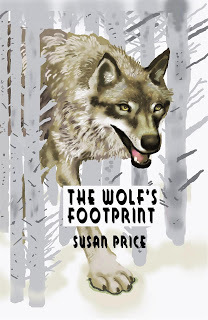 The Wolf's Footprint, Susan PriceYears ago, when I wrote The Wolf's Footprint, I took the children being abandoned in a forest from
The Wolf's Footprint, Susan PriceYears ago, when I wrote The Wolf's Footprint, I took the children being abandoned in a forest from the beginning of Hansel and Gretel and added a pinch of Russian folklore: the idea that if you drink water from an animal's footprint, then you turn into that animal.
It's always been popular in schools -- indeed Kate Stilitz turned it into a musical. You can read about that here.
It continues to be my best-seller as an Indie book -- in the UK, the US, in Canada, Australia and Europe. If I knew what it was about the book that appeals so much, I'd put it into everything I write.
Its popularity decided me to spend 2018 in re-publishing some of my books for the same age-group of eight to ten.
Like The Wolf's Footprint, they're a mixture of original story-telling and folklore.
The three I managed to get done -- with the help of my illustrator, Andrew -- are:-
Odin's Monster
Master Thomas Katt and
The Bone Dog.
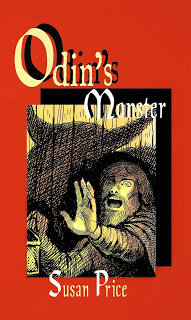 Odin's Monster, Susan PriceOdin's Monster is set further back in the past than the others: in the Viking Age. I based it loosely on the old Icelandic legend of 'Thorgeir's Bull.'
Odin's Monster, Susan PriceOdin's Monster is set further back in the past than the others: in the Viking Age. I based it loosely on the old Icelandic legend of 'Thorgeir's Bull.'A witch with a grudge creates a monster and sends it against his enemy -- who happens to be the book's hero, Thord Cat.
The tension racks up as the monster drives away Thord's friends and family until only the old beggar woman, Bergthora, is left to keep him company as he waits for the monster 'to come horned' and kill him.
When I'm reading it in schools, I stop at the point where Thord says, "Now I shall have to find out what it is like to die," and say, "If you want to find out how it ends, you'll have to read the rest yourself."
In one school a teacher who'd been listening, chin in hand, startled me by crying out, "Oh no! You can't stop there!" (I think she was a good teacher.)
The book has illustrations by Andrew Price. The picture on the cover is one of them.
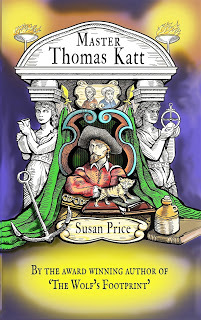 Master Thomas Kat, Susan Price
Master Thomas Kat, Susan Price Master Thomas Katt is set in the Elizabethan Age but it's loosely based on an old Danish folk-story I came on when I was reading every book of obscure folk-lore I could find.
In the folk-tale, an old, childless couple become so besotted with their bull-calf that they take him to be educated by the local clergyman, so that he'll be better fitted to manage the farm when he inherits it.
The clergyman defrauds the old couple of all their money by pretending to educate their calf -- but really, he kills the calf. And he gets away with it.
The lesson of the folk-tale seems to be: Fools deserve to be cheated. I didn't like this. I'd read that Elizabeth I said, "My laws shall ever protect the fools from the knaves." Perhaps it was this that gave me the idea of setting the book in Elizabeth's reign and making the Queen a character in it.
I changed the folk-tale. In my version, it's a kitten the old couple take to be educated -- and the Vicar doesn't get away with his villainy. He tells the old couple that their kitten has run away to sea and, years later, sends them on a wild goose chase (as he thinks) to the Miching Mouse Inn to meet 'Master Thomas Katt, just put in from the shores of Muscovy.' Master Katt, says the Vicar, is their kitten grown into a man.
When the poor old couple find the Miching Mouse, there really is a sea-captain named Thomas Katt and he takes up their cause and discovers that the Vicar has become the Queen's chaplain. Master Katt puts the case before the Queen, who is furious and wants to execute her chaplain forthwith. But Thomas Katt comes up with a better plan...
This book is illustrated too. Here's Master Tom Katt, just put in from Muscovy, listening to the tale of two strangers who think he is their kitten grown up.
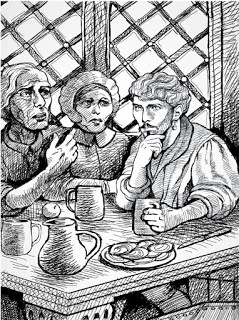
It's the tale of a tom-kitten that grew to be a Tom Katt.
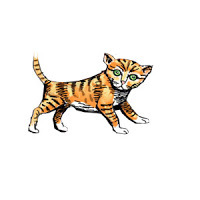
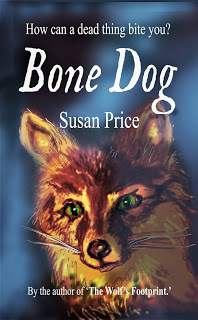 The Bone Dog, Susan Price
The Bone Dog, Susan Price
The Bone Dog has a contemporary setting but ideas from legend and folk-lore have still worked their way in.
Sarah longs for a pet but her parents won't let her have one because they are too expensive and messy. During the summer holidays Sarah goes, as usual, to stay with her grandmother and uncle Bryan who are, matter of factly, witches.
Her uncle promises to make her a pet that will never need to see the vet and won't need feeding. He does so by making her 'a bone dog' from an old fox fur collar belonging to his mother and a bone left over from a meal. He stitches the bone into the fur and brings the thing to life with suitable midnight ceremony.
Sarah teaches her pet tricks and treats it as a sophisticated toy -- until she discovers that she can see and hear what 'Reynardine' sees and hears. When she falls out with the girls next door, she uses her 'pet' to take revenge.
But the idea of a creature created from a bone and controlled by a witch comes from Icelandic legend. Icelandic witches were said to be able to create a 'milk carrier' from a human rib-bone. It would bowl off, end over end, to suckle milk from neighbours' cows and return to the witch with a cheery cry of, "My belly's full, Mummy!" It then vomited milk into a churn the witch had set ready. All very unsavoury. My bone dog is quite sinister but at least he doesn't run around up-chucking stolen milk all over the place.
Three books and all of them started with an idea drawn from folk-lore. I don't know where I'd be without my shelves of myths, legends and folk-lore.
Wishing you all a belated New Year - may it be prosperous. I hope your first-footer brought you plenty of cake, coal and whisky to see you through until this time 2020. (I think we may need it.)
Susan Price won the Carnegie medal for The Ghost DrumandThe Guardian Award for The Sterkarm Handshake.
Her website, with reviews, writing tips, short stories and book extracts is here.
Published on January 17, 2019 16:00
The Wolf's Footprint, Susan PriceYears ago, when I wrote ...
 The Wolf's Footprint, Susan PriceYears ago, when I wrote The Wolf's Footprint, I took the children being abandoned in a forest from
The Wolf's Footprint, Susan PriceYears ago, when I wrote The Wolf's Footprint, I took the children being abandoned in a forest from the beginning of Hansel and Gretel and added a pinch of Russian folklore: the idea that if you drink water from an animal's footprint, then you turn into that animal.
It's always been popular in schools -- indeed Kate Stilitz turned it into a musical. You can read about that here.
It continues to be my best-seller as an Indie book -- in the UK, the US, in Canada, Australia and Europe. If I knew what it was about the book that appeals so much, I'd put it into everything I write.
Its popularity decided me to spend 2018 in re-publishing some of my books for the same age-group of eight to ten.
Like The Wolf's Footprint, they're a mixture of original story-telling and folklore.
The three I managed to get done -- with the help of my illustrator, Andrew -- are:-
Odin's Monster
Master Thomas Katt and
The Bone Dog.
 Odin's Monster, Susan PriceOdin's Monster is set further back in the past than the others: in the Viking Age. I based it loosely on the old Icelandic legend of 'Thorgeir's Bull.'
Odin's Monster, Susan PriceOdin's Monster is set further back in the past than the others: in the Viking Age. I based it loosely on the old Icelandic legend of 'Thorgeir's Bull.'A witch with a grudge creates a monster and sends it against his enemy -- who happens to be the book's hero, Thord Cat.
The tension racks up as the monster drives away Thord's friends and family until only the old beggar woman, Bergthora, is left to keep him company as he waits for the monster 'to come horned' and kill him.
When I'm reading it in schools, I stop at the point where Thord says, "Now I shall have to find out what it is like to die," and say, "If you want to find out how it ends, you'll have to read the rest yourself."
In one school a teacher who'd been listening, chin in hand, startled me by crying out, "Oh no! You can't stop there!" (I think she was a good teacher.)
The book has illustrations by Andrew Price. The picture on the cover is one of them.
 Master Thomas Kat, Susan Price
Master Thomas Kat, Susan Price Master Thomas Katt is set in the Elizabethan Age but it's loosely based on an old Danish folk-story I came on when I was reading every book of obscure folk-lore I could find.
In the folk-tale, an old, childless couple become so besotted with their bull-calf that they take him to be educated by the local clergyman, so that he'll be better fitted to manage the farm when he inherits it.
The clergyman defrauds the old couple of all their money by pretending to educate their calf -- but really, he kills the calf. And he gets away with it.
The lesson of the folk-tale seems to be: Fools deserve to be cheated. I didn't like this. I'd read that Elizabeth I said, "My laws shall ever protect the fools from the knaves." Perhaps it was this that gave me the idea of setting the book in Elizabeth's reign and making the Queen a character in it.
I changed the folk-tale. In my version, it's a kitten the old couple take to be educated -- and the Vicar doesn't get away with his villainy. He tells the old couple that their kitten has run away to sea and, years later, sends them on a wild goose chase (as he thinks) to the Miching Mouse Inn to meet 'Master Thomas Katt, just put in from the shores of Muscovy.' Master Katt, says the Vicar, is their kitten grown into a man.
When the poor old couple find the Miching Mouse, there really is a sea-captain named Thomas Katt and he takes up their cause and discovers that the Vicar has become the Queen's chaplain. Master Katt puts the case before the Queen, who is furious and wants to execute her chaplain forthwith. But Thomas Katt comes up with a better plan...
This book is illustrated too. Here's Master Tom Katt, just put in from Muscovy, listening to the tale of two strangers who think he is their kitten grown up.

It's the tale of a tom-kitten that grew to be a Tom Katt.

 The Bone Dog, Susan Price
The Bone Dog, Susan Price
The Bone Dog has a contemporary setting but ideas from legend and folk-lore have still worked their way in.
Sarah longs for a pet but her parents won't let her have one because they are too expensive and messy. During the summer holidays Sarah goes, as usual, to stay with her grandmother and uncle Bryan who are, matter of factly, witches.
Her uncle promises to make her a pet that will never need to see the vet and won't need feeding. He does so by making her 'a bone dog' from an old fox fur collar belonging to his mother and a bone left over from a meal. He stitches the bone into the fur and brings the thing to life with suitable midnight ceremony.
Sarah teaches her pet tricks and treats it as a sophisticated toy -- until she discovers that she can see and hear what 'Reynardine' sees and hears. When she falls out with the girls next door, she uses her 'pet' to take revenge.
But the idea of a creature created from a bone and controlled by a witch comes from Icelandic legend. Icelandic witches were said to be able to create a 'milk carrier' from a human rib-bone. It would bowl off, end over end, to suckle milk from neighbours' cows and return to the witch with a cheery cry of, "My belly's full, Mummy!" It then vomited milk into a churn the witch had set ready. All very unsavoury. My bone dog is quite sinister but at least he doesn't run around up-chucking stolen milk all over the place.
Three books and all of them started with an idea drawn from folk-lore. I don't know where I'd be without my shelves of myths, legends and folk-lore.
Wishing you all a belated New Year - may it be prosperous. I hope your first-footer brought you plenty of cake, coal and whisky to see you through until this time 2020. (I think we may need it.)
Susan Price won the Carnegie medal for The Ghost DrumandThe Guardian Award for The Sterkarm Handshake.
Her website, with reviews, writing tips, short stories and book extracts is here.
Published on January 17, 2019 16:00
November 24, 2018
The Devil Stood on Dudley's Keep...
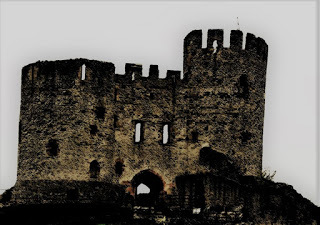 Dudley Castle, Wikimedia, Trevman99"The Devil stood on Dudley's keepAnd far about Him gazed,And said, 'I never more shall feelAt Hell's fierce flames amazed."
Dudley Castle, Wikimedia, Trevman99"The Devil stood on Dudley's keepAnd far about Him gazed,And said, 'I never more shall feelAt Hell's fierce flames amazed."If I look across the valley from my house, I can see Dudley Castle on the opposite hill.
A former owner, John Dudley, was executed for trying to put Lady Jane Grey on the throne and as a child I used to be told that it was 'one of the ruins that Cromwell knocked about a bit.' Parliament's guns were set up where the present day Castlegate roundabout is, just by the 24-hour Tesco's. (It's a long way from the castle and gives you an idea of just how big a castle's outer baileys were.)
But the rhyme above refers to the period when industry came to the Black Country, the period from, roughly, 1760 to 1860: the Industrial Revolution.
My Scottish partner has just told me, flatly, that 'nobody knows where the "Black Country" is.' So I'll tell you. It isn't Birmingham. That overgrown village with too high an opinion of itself is to the south-east.
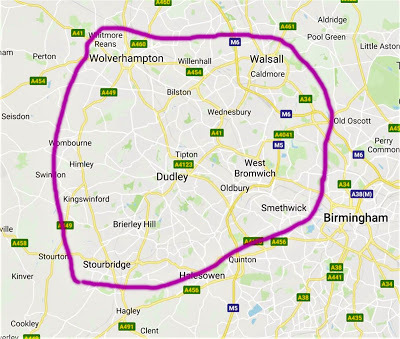
The Black Country was an area of small towns and villages until Industry arrived -- and Industry arrived because of the district's geology. Dudley Castle is built of limestone and the 'Seven Sisters' caverns beneath it are quarried from limestone. Where the Black Country isn't limestone, it's basalt, streaked with rust from the iron in it. Alongside enormous quarries there were enormous 'marl-holes': holes from which marl, or clay had been dug. And through the Black Country ran the massive thirty-foot coal seam. It was said to be the only place in the world where ladders were needed to cut coal.
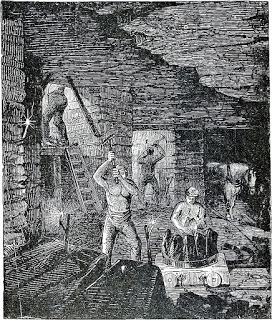 Cutting coal in 'the thick seam' -- Wikimedia, no restrictionsClay to make bricks to build factories; iron-ore for smelting iron; limestone to act as a flux for the iron; and coal to fire the furnaces. All of it within a small region which meant little time and energy would be spent hauling raw materials over roads little better than dirt tracks. Once canals were dug -- and the Black Country has many 'cuts' or canals -- the iron and coal could be floated right up to the factory's own quay.
Cutting coal in 'the thick seam' -- Wikimedia, no restrictionsClay to make bricks to build factories; iron-ore for smelting iron; limestone to act as a flux for the iron; and coal to fire the furnaces. All of it within a small region which meant little time and energy would be spent hauling raw materials over roads little better than dirt tracks. Once canals were dug -- and the Black Country has many 'cuts' or canals -- the iron and coal could be floated right up to the factory's own quay.Within a short time, the Black Country became a place of brick-works, coal-mines and iron-works. Coal had been mined and iron worked in the district for centuries. Small, family run mines were common where the thirty-foot seam came close to the surface and 'Smethwick' means 'the town of the smiths.' There had always been back-yard nail and chain shops in Dudley, Oldbury and Cradley Heath. But these had been small-scale cottage-industries, worked as and when demand was there or when the work-shop owners felt like it. At other times, they tended their pigs, chickens or vegetable patch.
But the 'Revolution' meant more mines and deeper; more nail and chain shops, more foundries, more steel mills. There was a sudden steep increase in exploitation too. It was the kind of capitalist free-for-all that the Tories are itching to return us to, if they can only get rid of all that nannying red-tape from the EU: all that wimpy stuff about workers' rights and air and water purity.
There was none of that fuss-potting in the old Black Country. The Agricultural Revolution had forced people off the land:'They hang the man and flog the womanWho steals a goose from off the Common--But leave the greater villain looseWho steals the Common from the goose.'
People poured into the Black Country from surrounding English counties, from Wales and from Ireland. They came to a place where there were no laws against child labour: children worked in factories and were lowered into mines on the end of a rope, to spend all day down there, in the dark, o be hauled up again after dark had fallen. Many fell to their deaths or were brained by objects falling from above. There were no safety rules, no guards on machinery, no minimum wage, no welfare -- not even something as inadequate as Universal Credit.
Great mechanical hammers pounded day and night, 'wildfire' burst out above ground from ill-kept mines, and a dense dark cloud of smoke and soot obscured daylight. It's said that, at night, the red glow from the foundries and forges reflected off the underside of this cloud of smoke.
"The Devil stood on Dudley's keepAnd far about Him gazed,And said, 'I never more shall feelAt Hell's fierce flames amazed."
The old Black Country was Hell on earth for most.

It's the setting of my book, The Ghost Wife.
The book was partly inspired by the Dudley Devil. His name was Theophilius Dunn and he was born in Netherton, a village near the town of Dudley, in 1790. He made a living as a witch, telling fortunes and 'finding things lost.' He was called 'Devil' because, like 'cunning man,' it was a name for a witch. He was known locally as 'Owd Offie.'
He was supposed to have been such an accomplished witch that 'great personages' came in carriages from as far away as Scotland to consult him. Despite such claims, he seems to have been the usual con-artist, doing business at all the local 'Wakes' or fairs, from a tent decorated with occult symbols. He sold charms and potions.
Theophilius Dunn hanged himself in 1851, at the age of 61. One story has it that he foretold the day of his own death. When that day came, finding himself in good health, he was so annoyed at the thought that one of his predictions wouldn't come true, he made sure it did.
My devil comes to a sticky end too, though not by hanging and I'd like to make it clear that my devil, though inspired by Dunn, is not intended to be a portrait of him. My devil, Amadeus Warley, is far more wicked. And, of course, has genuine supernatural powers.
Another of the characters, Rattle, goes to visit the Devil and has to walk through the town of Dudley (called 'Dudham' in the book) through its streets of slum dwellings, where blood and guts were washed downhill from the market-place beneath the castle walls. The narrow streets were often blocked with refuse, including human waste. A din of hammers rings out on all sides. Dudley was a nailing town.
Rattle is a 'pit bonk wench' -- a girl who usually works on the pit banks, loading coal onto carts, or carting away waste earth and rock to the 'pit bonks.' In my childhood, if a girl or woman was untidy or grubby, they were accused of 'looking like a pit-bonk wench.' The chains of figures cut out of newspaper to amuse children were always called 'pit-bonk wenches.' That, or 'brickle wenches' who were very similar wenches who worked in brick yards.
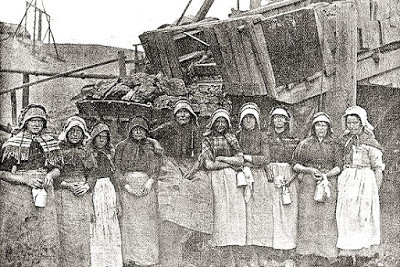 Pit bonk wenches
Pit bonk wenches The pit bonk wenches you did not mess with. They were muscular and they came mob-handed. Old photographs usually show them dressed in skirts, bonnets and big boots and grimy as anyone would be who worked loading coal all day. I think they'd dressed in their best for these photos, though, as the tales I was told as a child always described them as wearing an old flat cap that had once belonged to a male relative and often one of his old jackets too. Sometimes a shawl or sack was draped around the head and shoulders with the flat cap on top. And a pipe in the corner of the mouth.
I've never seen photos of them wearing trousers but they did. They often rode astride on the horses that pulled the carts and were climbing on and off carts all day. It was easier to wear trousers.
The Ghost Wife herself is not inspired by the Black Country at all. She stems from my reading of sinister Icelandic folk-tales about 'followers' -- a kind of ghost which attaches itself to a particular family and follows them relentlessly through generations. This is usually said to have happened because of a curse inflicted by a witch. The witch -- who was as often male as female -- created the ghost by murdering some luckless beggar and then sends the ghost against his or her enemy, to torment them or spy on them.
In the book a 'Methody' farming family had a rather less religious ancestor who drowned a beggar girl in order to create for himself a witch's familiar. The witch died -- but his familiar continues to haunt the farm-house and attaches herself to some unfortunate young man in every generation. As the Dudham Devil remarks, the classical writers would have called her a succubus.
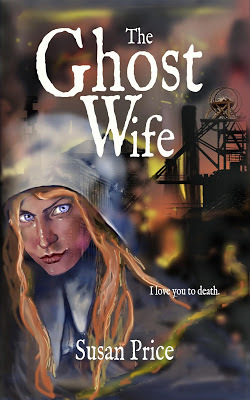
Paperback Ebook
Published on November 24, 2018 16:00
Dudley Castle, Wikimedia, Trevman99"The Devil stood on Du...
 Dudley Castle, Wikimedia, Trevman99"The Devil stood on Dudley's keepAnd far about Him gazed,And said, 'I never more shall feelAt Hell's fierce flames amazed."
Dudley Castle, Wikimedia, Trevman99"The Devil stood on Dudley's keepAnd far about Him gazed,And said, 'I never more shall feelAt Hell's fierce flames amazed."If I look across the valley from my house, I can see Dudley Castle on the opposite hill.
A former owner, John Dudley, was executed for trying to put Lady Jane Grey on the throne and as a child I used to be told that it was 'one of the ruins that Cromwell knocked about a bit.' Parliament's guns were set up where the present day Castlegate roundabout is, just by the 24-hour Tesco's. (It's a long way from the castle and gives you an idea of just how big a castle's outer baileys were.)
But the rhyme above refers to the period when industry came to the Black Country, the period from, roughly, 1760 to 1860: the Industrial Revolution.
My Scottish partner has just told me, flatly, that 'nobody knows where the "Black Country" is.' So I'll tell you. It isn't Birmingham. That overgrown village with too high an opinion of itself is to the south-east.

The Black Country was an area of small towns and villages until Industry arrived -- and Industry arrived because of the district's geology. Dudley Castle is built of limestone and the 'Seven Sisters' caverns beneath it are quarried from limestone. Where the Black Country isn't limestone, it's basalt, streaked with rust from the iron in it. Alongside enormous quarries there were enormous 'marl-holes': holes from which marl, or clay had been dug. And through the Black Country ran the massive thirty-foot coal seam. It was said to be the only place in the world where ladders were needed to cut coal.
 Cutting coal in 'the thick seam' -- Wikimedia, no restrictionsClay to make bricks to build factories; iron-ore for smelting iron; limestone to act as a flux for the iron; and coal to fire the furnaces. All of it within a small region which meant little time and energy would be spent hauling raw materials over roads little better than dirt tracks. Once canals were dug -- and the Black Country has many 'cuts' or canals -- the iron and coal could be floated right up to the factory's own quay.
Cutting coal in 'the thick seam' -- Wikimedia, no restrictionsClay to make bricks to build factories; iron-ore for smelting iron; limestone to act as a flux for the iron; and coal to fire the furnaces. All of it within a small region which meant little time and energy would be spent hauling raw materials over roads little better than dirt tracks. Once canals were dug -- and the Black Country has many 'cuts' or canals -- the iron and coal could be floated right up to the factory's own quay.Within a short time, the Black Country became a place of brick-works, coal-mines and iron-works. Coal had been mined and iron worked in the district for centuries. Small, family run mines were common where the thirty-foot seam came close to the surface and 'Smethwick' means 'the town of the smiths.' There had always been back-yard nail and chain shops in Dudley, Oldbury and Cradley Heath. But these had been small-scale cottage-industries, worked as and when demand was there or when the work-shop owners felt like it. At other times, they tended their pigs, chickens or vegetable patch.
But the 'Revolution' meant more mines and deeper; more nail and chain shops, more foundries, more steel mills. There was a sudden steep increase in exploitation too. It was the kind of capitalist free-for-all that the Tories are itching to return us to, if they can only get rid of all that nannying red-tape from the EU: all that wimpy stuff about workers' rights and air and water purity.
There was none of that fuss-potting in the old Black Country. The Agricultural Revolution had forced people off the land:'They hang the man and flog the womanWho steals a goose from off the Common--But leave the greater villain looseWho steals the Common from the goose.'
People poured into the Black Country from surrounding English counties, from Wales and from Ireland. They came to a place where there were no laws against child labour: children worked in factories and were lowered into mines on the end of a rope, to spend all day down there, in the dark, o be hauled up again after dark had fallen. Many fell to their deaths or were brained by objects falling from above. There were no safety rules, no guards on machinery, no minimum wage, no welfare -- not even something as inadequate as Universal Credit.
Great mechanical hammers pounded day and night, 'wildfire' burst out above ground from ill-kept mines, and a dense dark cloud of smoke and soot obscured daylight. It's said that, at night, the red glow from the foundries and forges reflected off the underside of this cloud of smoke.
"The Devil stood on Dudley's keepAnd far about Him gazed,And said, 'I never more shall feelAt Hell's fierce flames amazed."
The old Black Country was Hell on earth for most.

It's the setting of my book, The Ghost Wife.
The book was partly inspired by the Dudley Devil. His name was Theophilius Dunn and he was born in Netherton, a village near the town of Dudley, in 1790. He made a living as a witch, telling fortunes and 'finding things lost.' He was called 'Devil' because, like 'cunning man,' it was a name for a witch. He was known locally as 'Owd Offie.'
He was supposed to have been such an accomplished witch that 'great personages' came in carriages from as far away as Scotland to consult him. Despite such claims, he seems to have been the usual con-artist, doing business at all the local 'Wakes' or fairs, from a tent decorated with occult symbols. He sold charms and potions.
Theophilius Dunn hanged himself in 1851, at the age of 61. One story has it that he foretold the day of his own death. When that day came, finding himself in good health, he was so annoyed at the thought that one of his predictions wouldn't come true, he made sure it did.
My devil comes to a sticky end too, though not by hanging and I'd like to make it clear that my devil, though inspired by Dunn, is not intended to be a portrait of him. My devil, Amadeus Warley, is far more wicked. And, of course, has genuine supernatural powers.
Another of the characters, Rattle, goes to visit the Devil and has to walk through the town of Dudley (called 'Dudham' in the book) through its streets of slum dwellings, where blood and guts were washed downhill from the market-place beneath the castle walls. The narrow streets were often blocked with refuse, including human waste. A din of hammers rings out on all sides. Dudley was a nailing town.
Rattle is a 'pit bonk wench' -- a girl who usually works on the pit banks, loading coal onto carts, or carting away waste earth and rock to the 'pit bonks.' In my childhood, if a girl or woman was untidy or grubby, they were accused of 'looking like a pit-bonk wench.' The chains of figures cut out of newspaper to amuse children were always called 'pit-bonk wenches.' That, or 'brickle wenches' who were very similar wenches who worked in brick yards.
 Pit bonk wenches
Pit bonk wenches The pit bonk wenches you did not mess with. They were muscular and they came mob-handed. Old photographs usually show them dressed in skirts, bonnets and big boots and grimy as anyone would be who worked loading coal all day. I think they'd dressed in their best for these photos, though, as the tales I was told as a child always described them as wearing an old flat cap that had once belonged to a male relative and often one of his old jackets too. Sometimes a shawl or sack was draped around the head and shoulders with the flat cap on top. And a pipe in the corner of the mouth.
I've never seen photos of them wearing trousers but they did. They often rode astride on the horses that pulled the carts and were climbing on and off carts all day. It was easier to wear trousers.
The Ghost Wife herself is not inspired by the Black Country at all. She stems from my reading of sinister Icelandic folk-tales about 'followers' -- a kind of ghost which attaches itself to a particular family and follows them relentlessly through generations. This is usually said to have happened because of a curse inflicted by a witch. The witch -- who was as often male as female -- created the ghost by murdering some luckless beggar and then sends the ghost against his or her enemy, to torment them or spy on them.
In the book a 'Methody' farming family had a rather less religious ancestor who drowned a beggar girl in order to create for himself a witch's familiar. The witch died -- but his familiar continues to haunt the farm-house and attaches herself to some unfortunate young man in every generation. As the Dudham Devil remarks, the classical writers would have called her a succubus.

Paperback Ebook
Published on November 24, 2018 16:00
November 16, 2018
A Dip In The O.C.E.A.N
 Ocean surface wave. Jon Sullivan.
Ocean surface wave. Jon Sullivan. I read a few ‘how-to write’ books when younger but as I remember, they concentrated mostly on how to lay out your book and how best to approach publishers. Apart from that, they directed you back to good writers with the instruction to pay attention to the way, for instance, dialogue was used to tell the story and reinforce character. These peeled back the Art a little, so you could take a look at the hidden art.
Some things I’ve seen lately differ from this in that they seem to be trying to provide a formula or recipe for writing a story or novel. Write so many words, make chapters so long, put in so much description, add a certain mix of characters…
O.C.E.A.N, for instance. It stands for:—
Openness — Conscientiousness — Extraversion — Agreeableness — Neuroticism
It began as a a tool used by psychologists to assess patients but has been co-opted by writers to help them build and understand character. Each of these qualities is a sliding scale and probably no neuro-typical adult is 100% Open or 100% Closed. But the theory proposes that every personality is made up of these five qualities in various degrees. (That's if you even accept that such a thing as 'personality' exists. Psychologists and psychiatrists are punching it out in a secret arena even as I type.)
A high score for Openness supposedly makes you curious, imaginative, accepting of other groups’ moral codes and customs, unconventional.
A low score makes you nasty, bitter and twisted— Sorry, I'll re-phrase. It makes you narrow-minded (not that we’re being judgemental here. We’re being scientific.) It also means that you don’t analyse things, are rather incurious, and tend to find ‘foreign’ attitudes repugnant.
Conscientiousness measures the drive to complete tasks. Those scoring highly would be hard-working, punctual, driven, self-disciplined and always finish the job at hand. On time, of course. They sound like nightmares.
Those scoring low for C are laid-back, unreliable, pleasure-seeking and spontaneous. They sound almost as bad as the high-scorers.
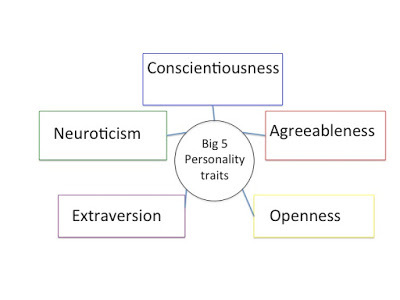 Diagram of the Big 5 Personlity Traits: wikimedia
Diagram of the Big 5 Personlity Traits: wikimediaExtraversion —measures the degree of extraversion (obviously) as opposed to introversion. Extraverts love stimulation and company. They have positive outlooks, are the life and soul, always take charge and I hate them. High-scorers on this quality are, apparently, the best leaders. Really? I wouldn’t follow them. Where are they going to lead you? Into the Valley of Death, I’m telling you, lured by all those stimulating, exciting flash-bangs and shell-screams.
A low score for E makes you an introvert. You find too much noise and chatter exhausting and painful. You hate parties and have a tendency to go to the furthest point of an empty Hebridean beach and read a book. Not too exciting a book, mind. Low Es tend to be pessimistic, dour and aloof. My kind of people.
Agreeableness — People who score high on Agreeableness are weak leaders, apparently. They are tolerant, sensitive, kind, warm— like Bhudda and Jesus, y'know. And nobody wants to follow them, obviously. But assuming that the scientists are correct and no one follows those high As -- well, right there, is what is wrong with the human race.
Those scoring highly on A are also forgiving and helpful, but gullible. I get the feeling that, if I ever take this test, I’m not going to score highly on A.
A low score for A makes you suspicious and antagonistic; quick to assert your own rights, irritable, vindictive, uncooperative and rude. Now there is a thumbnail portrait of me that my nearest and cowed would immediately recognise.
Neuroticism — I’ve never been sure what this means, apart from being a word psychologists and doctors use to insult you. Especially if you’re a woman. Apparently, it means ‘emotional instability.’ A tendency to feel sadness. (You mean, there’s an option not to? Where do I sign up?) A tendency to feel vulnerable and, as result, to be anxious, moody, quick-tempered.
A high-scorer is likely to be a hypochondriac, worrying over every little twinge— or one of those who constantly invents horrifying scenarios which ‘might happen’ and then worries themselves into fits over them.
A low scorer is calm and unemotional, self-reliant and wastes no time worrying, to the point of being complacent.
Psychologists presumably find OCEAN useful, though I’m not sure why. I doubt I’m the only person who would simply supply the answers best guaranteed to have the good doctor eating from my hand. Which is exactly what psychopaths do and it’s why they get worse with treatment, not better. Instead of 'working on themselves' and becoming better people every day, they quickly learn exactly what to say to convince the trick-cyclists that they've reformed and can be safely released immediately. But then, psychopaths and me, we’re low on Agreeableness, which makes us manipulative.
It’s suggested that writers use OCEAN's sliding scales to map out our characters, to help us figure out how they will react in any given situation. Presumably, we draw a graph for each one. Consulting our graphs, we can easily see that, if asked to make tea for everyone, A will smile and rush to the kitchen because A scores high on Agreeableness — whereas B will tell everyone where they can go because B scores low. And C wouldn’t even be at the meeting, because C is an introvert.
You can also, it’s said, use these sliding scales to plot a change in a particular characteristic. A character begins a story as overly driven and conscientious but in the course of the story learns to cheer up and relax, little square by little square, as you mark up your graph.
I have occasionally found this diagrammatic approach helpful with plots— but only after I’ve written three-parts of the book in my usual pantser, make-it-up-as-I-go-along style anyway. But it can help, when stuck for an ending, to lay a transparency of a perfect plot over the mess I’ve created and see if this suggests any stream-lining, or points broadly in the direction of a conclusion.
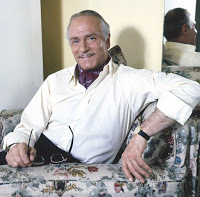 'Dear Boy, why not try acting?'But I could never begin with ‘The Plan’ and then stick to it. I would find it stifling. I feel the same way about OCEAN. These tricks and schemes always remind me of the anecdote about Laurence Olivier. He spent a long time listening to Dustin Hoffman explain The Method and then said: ‘Dear boy, why don’t you simply try acting?’
'Dear Boy, why not try acting?'But I could never begin with ‘The Plan’ and then stick to it. I would find it stifling. I feel the same way about OCEAN. These tricks and schemes always remind me of the anecdote about Laurence Olivier. He spent a long time listening to Dustin Hoffman explain The Method and then said: ‘Dear boy, why don’t you simply try acting?’For me, characters emerge, from the story you’re telling. For instance, Sandy in The Drover’s Dogs. The idea for the story came from reading about Highland cattle drovers in the 18th and 19th centuries and how they sent their herd dogs home alone while they stayed on at the lowland farms to earn money by helping with the harvest. I wanted to write about those dogs and their independent trek across Scotland for years.
Books seldom come from one idea. Ideas have to cross-pollinate. The cross-pollination happened when my partner told me about the ‘bonders’ of Scotland— farm labourers who were almost slaves. They were often mistreated but if they ran away, would be returned to their bond-owner by the authorities, just as slaves were.
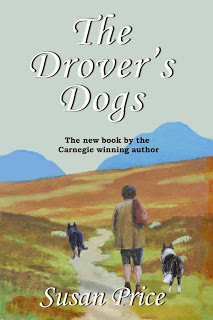 The Drover's Dogs by Susan PriceI imagined a boy in eastern Scotland, running away from a bond he hated and meeting a couple of herd-dogs on their way west, returning to their home in Mull. I needed a character who, though a child, was capable of taking the decision to run away and capable of surviving alone as he trudged more than a hundred miles over rough country.
The Drover's Dogs by Susan PriceI imagined a boy in eastern Scotland, running away from a bond he hated and meeting a couple of herd-dogs on their way west, returning to their home in Mull. I needed a character who, though a child, was capable of taking the decision to run away and capable of surviving alone as he trudged more than a hundred miles over rough country.He had to be a boy who willing to leave his family— so the circumstances of the story dictate the characters of the rest of the family too. Runaways rarely come from happy homes.
I remembered some Scots friends talking about their country childhoods. Once they could walk, they said, home was somewhere they ate breakfast and slept. They always had string, matches and a penknife in their pockets. When they were hungry, they made a fire, stole potatoes from the edge of a field and set them to roast, caught some ‘troot’ with their string, and enjoyed ‘fish and tatties.’ They knew where to find mushrooms, berries and nuts. They stayed outside until long after dark, even when the weather was below freezing. They knew -- without ever seeing Ray Mears or Bear Grylls -- how to build themselves a shelter.
I drew on this in creating Sandy, a hardy, tough little nut. He’s about ten, but already works whenever he can. His relationship with his family is distant because he’s hardly ever at home. After his mother bonds him to a neighbouring farmer, he feels that he owes his parents little. He can’t bear the thought of spending the next ten years as a bonder and runs. He's far more scared of being caught and possibly hung (for stealing himself) than he is of surviving on his own. He knows he can do that.
He readily and gladly befriends the two dogs he meets but is suspicious and fearful of people because they might inform on him and have him sent back to his bond-owner. There is always another, opposing and almost equally strong side to a character, though. Despite his self-reliance and hardiness, Sandy longs to find a safe home where he can drop his guard, where there are people who love and value him. When he finds such a home, his loyalty to his new family is deep.
I didn’t need to plot his Openness, Conscientiousness, Extraversion, Agreeableness and Neuroticism. I only had to think about the background and time that had formed him.
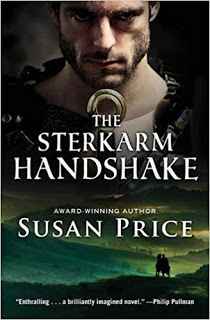 The Sterkarm Handshake by Susan PriceIt was the same with my Sterkarm books. The Sterkarms are a reiver family, living in a pele tower on the lawless Scottish borders of the sixteenth century. The young hero, Per Sterkarm, is the son of the tower’s laird, which immediately gives him status. It supplies confidence and a ‘sense of entitlement’ but is also something he has to live up to. He can’t lose face or back down from confrontation.
The Sterkarm Handshake by Susan PriceIt was the same with my Sterkarm books. The Sterkarms are a reiver family, living in a pele tower on the lawless Scottish borders of the sixteenth century. The young hero, Per Sterkarm, is the son of the tower’s laird, which immediately gives him status. It supplies confidence and a ‘sense of entitlement’ but is also something he has to live up to. He can’t lose face or back down from confrontation.Despite the title of ‘laird,’ his family are glorified cattle farmers in a poor and embattled part of the country, where life was always hard and often desperate. People had to stick together and help each other -- but also be prepared to defend what they had against outsiders. This means that Per has been raised with the attitude ‘Ourselves Alone.’ Everyone outside his family is the enemy and since family is the only security, loyalty to family is everything.
His formal schooling was negligible, but he trained to ride, to shoot with a bow and to fight with weapons from a young age. Physical confidence can be added to his general bumptiousness.
We end with a young man who can be charming when it suits him to be— and generous because in his world, generosity is how you display your status and keep the all-important friends and allies. Per loves the Elf-woman Andrea (who is really a time-traveller) and he is quick to defend her— but when he has to choose between her and his family, he always -- to her dismay -- chooses his family. It would be impossible for him to do anything else.
Capable as he is of charm, if crossed or cornered, he can be murderous— and cunning and treacherous. He cannot bear to lose face in his family’s eyes and he will win by whatever means he has to undertake. As Per sees it, lying is only wrong if he lies to a Sterkarm; treachery is only treacherous if used against Sterkarms. He acknowledges no authority except that of his family— which confuses the time-travelling executive Windsor, who expects obedience from those he sees as beneath him. (And as Per is much younger and one of the 16th-Century 'natives armed with sticks,' Windsor considers him very much beneath him.)
Again, Per’s character rose from his background, his influences, his upbringing. I don’t think that sitting with a blank sheet of paper or screen and trying to calculate how neurotic, agreeable or conscientious he was would have helped.
I could, now, give you his readings for all the qualities. Openness? Almost zero. Accepting of the codes and customs of others? No. It's his family’s way or nothing.
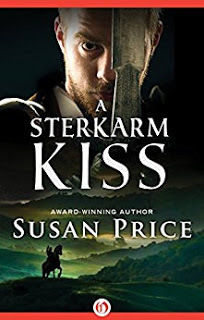 A Sterkarm Kiss by Susan PriceConscientiousness? Middling. Per's world isn't run by the clock, but by the sun and the seasons. If something seemed to him important and necessary, he would do it, or make sure others did it. The buildings had to be repaired before winter, for instance and there had to be enough fuel to last through the worst of the snow. If a raid ran off their cattle, they had to get out there and ride. This wasn't a matter of conscientiousness but of necessity.
A Sterkarm Kiss by Susan PriceConscientiousness? Middling. Per's world isn't run by the clock, but by the sun and the seasons. If something seemed to him important and necessary, he would do it, or make sure others did it. The buildings had to be repaired before winter, for instance and there had to be enough fuel to last through the worst of the snow. If a raid ran off their cattle, they had to get out there and ride. This wasn't a matter of conscientiousness but of necessity.On the other hand, when not pressed by necessity, there's plenty that can wait, especially if there's something better to do, like ale, women and song. (I think this reveals that the OCEAN scale was invented for a 21st Century society -- and only a small part of this society -- that orders its life by the clock.)
Extraversion? Per would score pretty high, but how much this is an inborn quality and how much something his upbringing would have engrained, is hard to say. Life in a pele-tower granted very little quiet or privacy. And when you're a big fish in a very small pond, you're pretty sure that the company is going to welcome you. -- In Handshake, when Per is translated to a 21st Century hospital, he becomes rather shy.
Agreeableness. Per would encompass the whole scale of Agreeableness, from 0 to 100%. On the low end of the scale, he's certainly capable of being vindictive. In fact, his whole family pride themselves on how very vindictive they are. Revenge was a duty. Where there is no reliable force of law to act as a deterrent, then the reputation for being willing and able to take revenge for any slight becomes an important protection. You touch not the Sterkarms with impunity.
Per can certainly be very quick to assert his own rights and inventively uncooperative. But he and his family can also be kind and warm, sensitive to others and helpful. Hospitality was as much a duty as revenge.
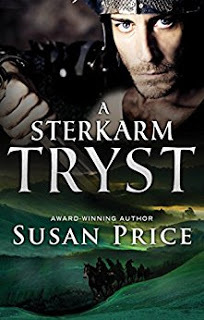 A Sterkarm Tryst by Susan PriceNeurotic? Well, if being neurotic is the opposite of 'calm and unemotional' then the whole Sterkarm family would probably score high on the Neurotic scale. Their time and place imposed a high degree of day-to-day anxiety. They were at the mercy of the weather and harvests. They never knew when they were going to be attacked. Moodiness, quick temper and raw emotions all round.
A Sterkarm Tryst by Susan PriceNeurotic? Well, if being neurotic is the opposite of 'calm and unemotional' then the whole Sterkarm family would probably score high on the Neurotic scale. Their time and place imposed a high degree of day-to-day anxiety. They were at the mercy of the weather and harvests. They never knew when they were going to be attacked. Moodiness, quick temper and raw emotions all round.But though I've used OCEAN to express this character reading, I didn't arrive at it by using OCEAN. Instead, I studied the time and place the Sterkarms lived in and their way of life. I thought about how it would shape them. I’m tempted to say to those who favour OCEAN, ‘Dear thing, why don’t you simply try writing?’
But perhaps I’m being too harsh. Perhaps I've even misunderstand how OCEAN is meant to be used?
I’d be interested to know how others feel. Is OCEAN something you’d find useful in creating characters? Something you’d consider trying?
Or, if not, how do you get to know your characters?
Susan Price won the Carnegie Medal for The Ghost Drum and the Guardian Fiction Award for The Sterkarm Handshake.Find out more at her website.
Published on November 16, 2018 16:00
September 2, 2018
Multiplying, Colour-Burn and Gaussian Blur
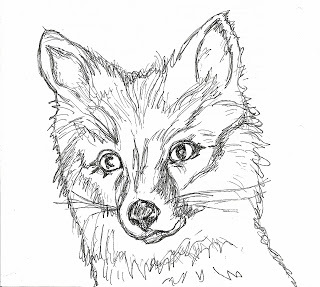
I started with this, drawn on a sheet of scrap paper, copied from a photo of a stuffed fox. I scanned it into the computer. Before I adjusted the contrasts, you could see the type showing through from the other side.
Then I opened the ink sketch in Photoshop, took out the white background of the scrap paper and added a dark background layer. Coloured the drawing, added a title and a screamer.
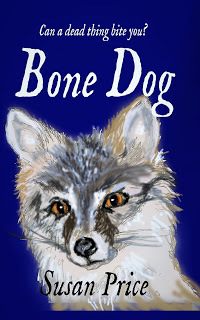
This is only a try-out for the front cover. I can't do the complete one until I've finished laying out the interior and know how thick the spine will be.
I used various photos for reference, sometimes using the 'eye-dropper' tool to get an idea of what the colouring should be.
I was so pleased with the result that I hailed a passing brother. "Cop a butcher's at this," I said.
He came, he looked. A long silence. Then, grudgingly, "That's pretty good. Come out of it."
He took over my chair. He over-layered in violet and red. He lowered opacity, multiplied and colour-burned. Recklessly, he employed the polygonal lasso and the Gaussian blur...
My good friend Karen Bush tells me that she likes it, but the nose of the fox is a bit wonky. It is, I know, but I don't care. The original stuffed fox in the photo may have had its nose put out of joint -- and in any case the 'bone dog' of the story is a sort of Frankenstein fox, created by witch-craft from an old fox-fur clumsily stitched together.
Here's the completed cover.

Amazon 'suppressed' it for a while because they weren't convinced I own the publishing rights. They seem to do this with every book published with Createspace now, which I suppose is a good thing. Frustrating, though. My friend, the above mentioned Karen Bush, a retired member of this blog, was all set to publish her book about how to deal with your dog's fear of fireworks and had arranged an article in Your Dog magazine to help publicise it. But because Amazon suppressed her book she now doubts whether she'll be able to get a proof copy and make any alterations before the article appears.
You can find out about Karen's books on dog-training here.
The Bone Dog is part of a project of mine -- to republish all my out of print books for the age-group 8--10. Since The Wolf's Footprint is my best-seller among my indie-books, it seems to make sense to publish more for that market.
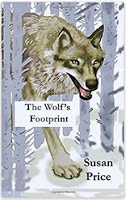 The Wolf's Footprint
The Wolf's Footprint
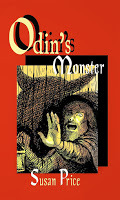 Odin's Monster
Odin's Monster Bone Dog is available now, both as paperback and kindle
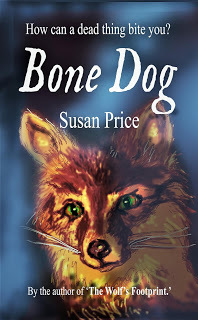

Published on September 02, 2018 16:00
July 16, 2018
Sweating with Wolves
 The wolves come...
The wolves come...Friday 13th may be unlucky for some, but not for me.
On Friday July 13th I went into London, to Tiverton Primary School in Tottenham, to see the second performance of a musical play based on my book, The Wolf's Footprint.
It was an exhaustingly hot day -- and I got lost. Now, I live in the Midlands and there I often here it said, "Oh, the people in London aren't friendly. They're rude, they won't give you the time of day," and all this kind of guff.
I am here to tell you, this is an absolute untruth. I interrupted several people as they were going about their business, to ask the way to Tiverton School and every single one of these randomly selected people was as friendly and helpful as could be. Several pulled out smart-phones and entered the name of the school, so they could show me where it was and guide me on my way. Thanks to them, I found Tiverton in time for the afternoon session.
So thank you, kindly people of Haringey and Tottenham and especially those -- you know who you are -- who were stopped by a hot and dishevelled writer asking, "Do you know where Tiverton School is?"
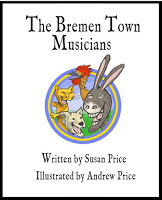 At the school I spent the afternoon talking with two great classes about -- oh, how a writer works, the writing of Bremen Town Musicians, ghosts, wolves, fairy-tales. I had a great time. I only hope the children had half as good a time as I did. (If only it had been a bit less hot!)
At the school I spent the afternoon talking with two great classes about -- oh, how a writer works, the writing of Bremen Town Musicians, ghosts, wolves, fairy-tales. I had a great time. I only hope the children had half as good a time as I did. (If only it had been a bit less hot!)Then I got to relax in the staff-room and chat to violinist Anna Jenkins and drummer Sebastien Hankin until it was time for the evening performance.
The play was first performed in 2014 and you can read about it here.
The performance this year, with a different cast, was every bit as good. As as I said at the end, I knew how it was going to turn out, but I was on the edge of my seat the whole time.
 Wicked courtiers try to dissuade the king from helping his starving people -- in song!
Wicked courtiers try to dissuade the king from helping his starving people -- in song!The music moves from the sad and poignant to the boisterous and joyful -- and how the children danced so energetically -- with encores! -- in that heat, I don't know, but they did. The oldest cast members were no more than twelve but they performed with a confidence and engagement that was a delight.
When Resham Mirza, the admirable head-teacher, tweeted that she had watched the show 'with pride,
joy and admiration' I could only echo her. As the head of this wonderful school she has good reason to be proud. As the Head Governer of the school told me, as we sat in the front row, Resham not only nutures all kinds of artistic expression at the school, but they have great academic results too.

 And, of course, there is Kate Stilitz, who wrote the music and lyrics and directed, drawing such wonderful performances from her young cast. Follow the link for a look at Kate's website, where you can see something of the many song-cycles and musical pieces she has written for children to perform.
And, of course, there is Kate Stilitz, who wrote the music and lyrics and directed, drawing such wonderful performances from her young cast. Follow the link for a look at Kate's website, where you can see something of the many song-cycles and musical pieces she has written for children to perform. The villagers celebrate the arrival of food.
The villagers celebrate the arrival of food.Kate also supplied the trumpeter, Ruben, as he's her son! Grow your own, that's the way.
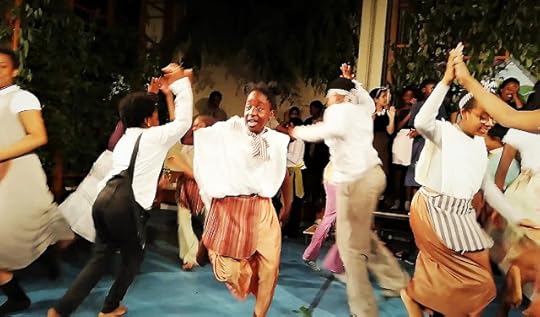
Tiverton School website
Kate Stilitz's website
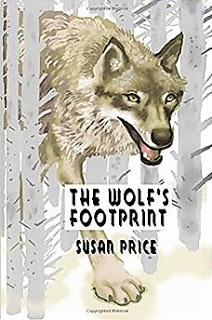
Find it on Amazon
Published on July 16, 2018 16:00
July 6, 2018
Elfgift and ElfKing by Susan Price On I go with re-issuin...
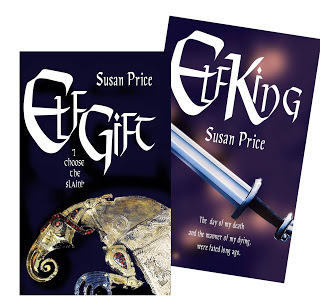 Elfgift and ElfKing by Susan Price
Elfgift and ElfKing by Susan PriceOn I go with re-issuing my back-list.
ElfKing would have been out sooner if I could have tracked down a better image for the cover.
I tried using another wikimedia image from the Sutton Hoo hoard... the famous 'man between wolves' from the purse-lid. The original is infilled with scarlet enamel and some think it represents the god Odin (who is a character in ElfKing.)
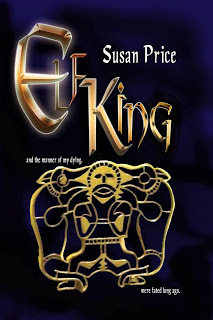 Trouble was, the rounded shape of the jewel just didn't work with the rectangle of the cover. No matter how I enlarged it, or moved it or the lettering about, the rounded shape just looked wrong.
Trouble was, the rounded shape of the jewel just didn't work with the rectangle of the cover. No matter how I enlarged it, or moved it or the lettering about, the rounded shape just looked wrong.Besides, my brother said the man 'had a silly face.'
So I used another image, one taken from a helmet plate. The book contains a couple of characters who are almost a Norse version of the Greek 'Heavenly Twins.' (There are some hints that Norse Myth did once have twin brother gods, a little like the Gemini or Dioskouri.)
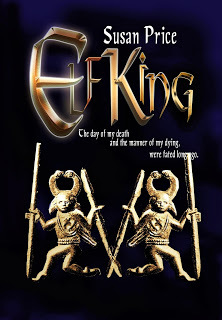 This works a little better as a design, I think but although the prancing warriors are authentically Viking Age, they are, well, a bit silly.
This works a little better as a design, I think but although the prancing warriors are authentically Viking Age, they are, well, a bit silly.Just a bit. With their chubby little legs.
I decided I just had to get a cover done and stop messing about with PhotoShop. So I decided on a sword.
As my colleague and friend Katherine Roberts remarked a couple of days ago, a sword isn't a very original image for a fantasy cover. But it says, clearly, 'This is a book with sword-fighting in it. And if you like books with sword-fighting, you might like this.'
Sometimes, you just have to get on with stuff.
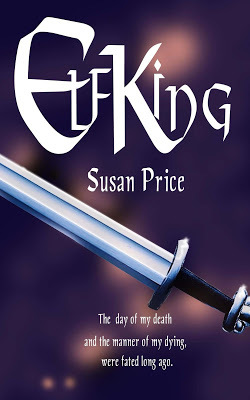
After all the work I put into the gold lettering, I decided that the plain white lettering looked much better. So much so, that I went back and made the lettering on Elfgift plain white too.
The slogan on the front of the book, says, 'The day of my death and the manner of my dying were fated long ago.' This isn't really mine. It's a deliberate misquote from the Norse Myths. The god Freyr sends his servant, Skirnir, on a dangerous mission into Giant's Home, to demand the beautiful giantess, Gerd, in marriage. Asked if he isn't afraid to make such a journey, Skirnir replies, why should he be? The length of his life and the day of his death were fated long ago. If he's fated to die in Giant's Home, he will. If not, not. His being afraid won't make any difference to Fate.
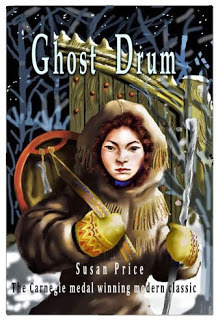 Ghost Drum by Susan Price(I used the first part of Skirnir's reply in
Ghost Drum
. Skirnir says: 'Fearlessness is better than faint-heart for any man who puts his nose out of doors.' In Ghost Drum it became, after various rewrites, it bcame the homelier, 'Whenever you poke your nose round the door, pack courage and leave fear at home.'
Ghost Drum by Susan Price(I used the first part of Skirnir's reply in
Ghost Drum
. Skirnir says: 'Fearlessness is better than faint-heart for any man who puts his nose out of doors.' In Ghost Drum it became, after various rewrites, it bcame the homelier, 'Whenever you poke your nose round the door, pack courage and leave fear at home.' The Norse Myths have been a constant inspiration for me. I don't know if I would even have become a writer if I hadn't collided with them at eleven.)
Oh well. The next task is to get the books up as Kindles. If I can remember how.
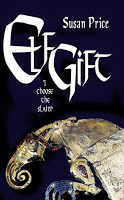
Buy Elfgift
Paperback
e-book
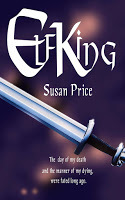
Buy ElfKing Paperback e-book
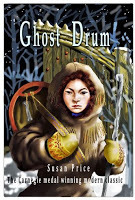 Buy Ghost Drum Paperback e-book
Buy Ghost Drum Paperback e-book Visit Susan Price's website

Published on July 06, 2018 16:00
Susan Price's Nennius Blog
"I have made a little heap of all I've found..."
"I have made a little heap of all I've found..."
...more
- Susan Price's profile
- 71 followers



